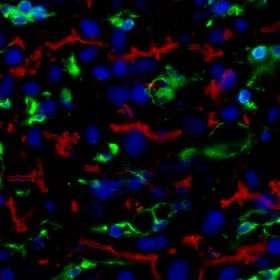Key protein for hepatitis C virus entry identified

For as many as 200 million people worldwide infected with hepatitis C, a leading cause of chronic liver disease, treatment options are only partially effective. But new research by Rockefeller University scientists points to a potential new target for better drugs: a key protein that resides in human liver cells that hepatitis C requires for entry.
Scientists have known that for HCV to infect human cells, at least two molecules — CD81 and SR-B1 — must be present on the surface of the cell. However, they suspected that at least one other molecule also has to be present, because in some cells that contained the known molecules HCV was still unable to gain entry.
Co-first authors Matthew Evans and Thomas von Hahn, postdoctoral associates in Rockefeller’s Laboratory of Virology and Infectious Disease led by Charlie Rice, set out to find the missing receptor. HCV is notorious for being too difficult to replicate in cell culture, so Evans and von Hahn used HCV “pseudoparticles,” HIV particles in which the HIV envelope proteins are replaced with those from HCV. This replacement tricks the host cell into allowing the engineered particle to enter in a manner identical to that of authentic HCV. Once inside the cell, however, the HIV replication machinery takes over.
In order to identify potential entry receptors, Evans and von Hahn teamed up with co-authors Theodora Hatziioannou and Paul Bieniasz, HIV researchers at Rockefeller and the Aaron Diamond AIDS Research Center who had developed a special multiple-round screening technique. The screen pointed them to claudin-1, a protein involved in the maintenance of cell structures called tight junctions that is found in several epithelial tissues in the body, and is most prevalent in the liver.
A series of experiments on various human cell lines confirmed that claudin-1 is a requirement for HCV entry, says von Hahn. The research showed that the HCV pseudoparticle was able to enter cells that contain claudin-1, as well as claudin-1-deficient cells that were made to artificially express the protein, but not other cells. “We did not see HCV enter any cell that did not have claudin-1,” says von Hahn.
Further experiments showed that claudin-1 only appears to come into play after the virus has bound to the cell, perhaps as a means for the virion to actually be taken up by the cell or facilitate fusion between the virus and cell membranes. The scientists reported their findings this week in an advance online publication in the journal Nature.
The researchers believe that there may be additional receptors – yet to be identified – that are necessary for HCV to infect cells, as some human cell lines contain all three receptors but still do not become infected. HCV also does not enter some human cells that express all three factors, nor can it infect mouse cells that have been engineered to express the three human receptors.
The identification of claudin-1, and the possible discovery of additional host cell receptors, offers the promise of new avenues for anti-HCV therapeutics, according to the authors.
“Anti-HCV drugs currently under development are directed against viral enzymes required for viral replication, to which the virus can readily evolve resistance,” says Evans. “HCV may be less able to develop resistance to drugs targeting receptors on the host cell.”
“We also foresee the potential for combination therapies, which would attack different stages of HCV infection, much like the HIV cocktail that has been so effective,” says Rice, who is the Maurice R. and Corinne P. Greenberg Professor and scientific director of the Center for the Study of Hepatitis C, a cooperative endeavor of Rockefeller, Weill Medical College of Cornell University and NewYork-Presbyterian Hospital.
Citation: Nature Online: February 25, 2007
Source: Rockefeller University




















